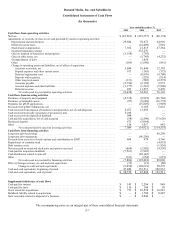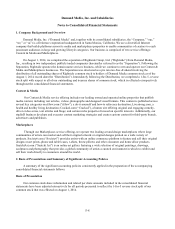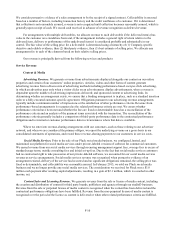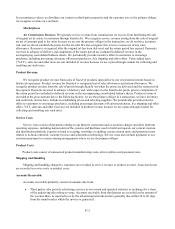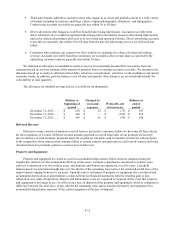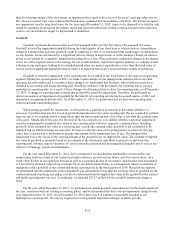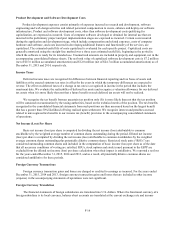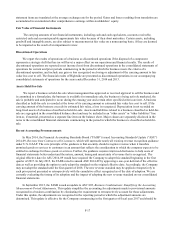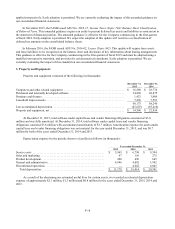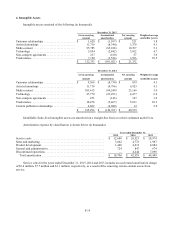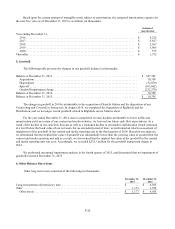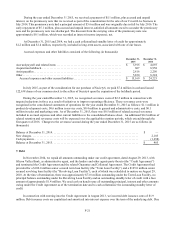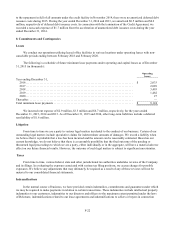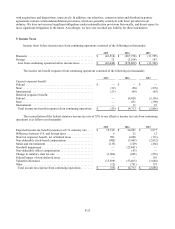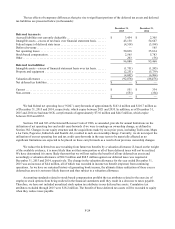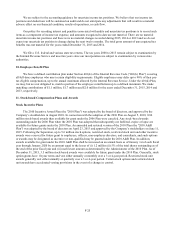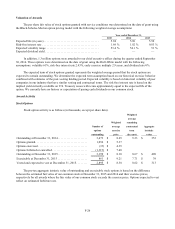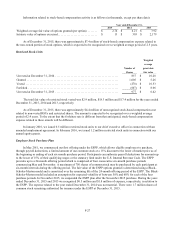Enom 2015 Annual Report Download - page 81
Download and view the complete annual report
Please find page 81 of the 2015 Enom annual report below. You can navigate through the pages in the report by either clicking on the pages listed below, or by using the keyword search tool below to find specific information within the annual report.
F-17
statement items are translated at the average exchange rate for the period. Gains and losses resulting from translation are
accumulated in accumulated other comprehensive earnings within stockholders’ equity.
Fair Value of Financial Instruments
The carrying amounts of our financial instruments, including cash and cash equivalents, accounts receivable,
restricted cash and accounts payable approximate fair value because of their short maturities. Certain assets, including
goodwill and intangible assets, are also subject to measurement at fair value on a nonrecurring basis, if they are deemed
to be impaired as the result of an impairment review.
Discontinued Operations
We report the results of operations of a business as discontinued operations if the disposal of a component
represents a strategic shift that has (or will have) a major effect on our operations and financial results. The results of
discontinued operations are reported in net income (loss) from discontinued operations in the consolidated statements of
operations for current and prior periods commencing in the period in which the business meets the criteria of a
discontinued operation, and include any gain or loss recognized on closing or adjustment of the carrying amount to fair
value less cost to sell. The financial results of Rightside are presented as discontinued operations in our accompanying
consolidated statements of operations for the years ended December 31, 2014 and 2013.
Assets Held-For-Sale
We report a business as held-for-sale when management has approved or received approval to sell the business and
is committed to a formal plan, the business is available for immediate sale, the business is being actively marketed, the
sale is probable and anticipated to occur during the ensuing year and certain other specified criteria are met. A business
classified as held-for-sale is recorded at the lower of its carrying amount or estimated fair value less cost to sell. If the
carrying amount of the business exceeds its estimated fair value, a loss is recognized. Depreciation is not recorded on
long-lived assets of a business classified as held-for-sale. Assets and liabilities related to a business classified as held-for-
sale are segregated in the consolidated balance sheet and may be included in an “other assets” or “other liabilities” line
item or, if material, presented as a separate line item on the balance sheet. Major classes are separately disclosed in the
notes to the consolidated financial statements commencing in the period in which the business is classified as held-for-
sale.
Recent Accounting Pronouncements
In May 2014, the Financial Accounting Standards Board (“FASB”) issued Accounting Standards Update (“ASU”)
2014-09, Revenue from Contracts with Customers, which will supersede nearly all existing revenue recognition guidance
under U.S. GAAP. The core principle of the guidance is that an entity should recognize revenue when it transfers
promised goods or services to customers in an amount that reflects the consideration to which the company expects to be
entitled in exchange for those goods or services. Further, the guidance requires improved disclosures to help users of
financial statements better understand the nature, amount, timing and uncertainty of revenue that is recognized. The
original effective date for ASU 2014-09 would have required the Company to adopt this standard beginning in the first
quarter of 2017. In July 2015, the FASB voted to amend ASU 2014-09 by approving a one-year deferral of the effective
date as well as providing the option to early adopt the standard on the original effective date. Accordingly, the Company
may not adopt the standard until the first quarter of 2018. The new revenue standard may be applied retrospectively to
each prior period presented or retrospectively with the cumulative effect recognized as of the date of adoption. We are
currently evaluating the timing of its adoption and the impact of adopting the new revenue standard on our consolidated
financial statements.
In September 2015, the FASB issued an update to ASC 805, Business Combinations: Simplifying the Accounting
Measurement-Period Adjustments. This update simplifies the accounting for adjustments made to provisional amounts
recognized in a business combination by eliminating the requirement to retrospectively account for those adjustments.
Under this update, the adjustments are recognized in the reporting period in which the adjustment amounts are
determined. This update is effective for the Company commencing in the first quarter of fiscal year 2017 and should be


